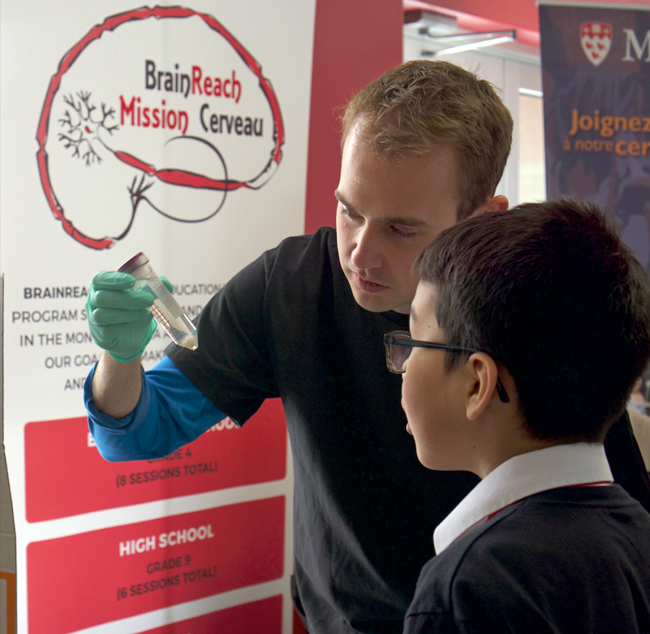
By Scott A. Holmes
“Where knowledge enlightens,” a perfect title to this year’s aboriginal science fair hosted by the Kiuna centre in the Odanak region of Quebec. Now in its 17th year, this fair represents an opportunity for young minds from aboriginal communities across Quebec to share their scientific interests and learn from others through conference. With attending students and their chaperones representing 16 aboriginal communities, students came in from regions that ranged as far North as the Quataq community in Canada’s arctic and as far South as the Kanesataka community in the Southwest of Quebec.
We were fortunate to be a part of this year’s science fair as members of the McGill IPN’s program BrainReach North, a program dedicated to making science available to remote communities with a special focus on aboriginal education in Quebec. As a young program at McGill, our goal of attending this year’s fair was to talk with students about their science and learn from them, their parents, and their teachers on methods of how to improve science education and interest.
For the science fair, BrainReach North partnered up with First People’s House and Let’s Talk Science, another volunteer-run education outreach program, for a two-day adventure that would have us learning as much as we hoped to one day teach.
The students at this year’s science fair were nothing short of amazing. Ranging in ages from grade 5 to secondary 5, the talent and enthusiasm about science came through clear. The projects were captivating. Students were exploring everything from mechanical engineering by building artificial motors, to understanding human nutrition and how persons could survive in the wilderness based on local flora and fauna. Students were learning and applying scientific principles by extracting procedures for commercial products, reproducing them, and altering critical ingredients to improve their performance. They were even exploring health conditions that either they, or their family were experiencing, showing how they could engage with their surrounding, learn from it, and improve their lives and those around them.
At the end of the two-day science fair, our group walked out with four critical pieces of information. First, we were blown away by not only the eagerness of students to learn about their own projects but about other students as well. They engaged in continuous dialogue, offering insight and constructive criticism to other students that mirrored the collegial atmosphere usually reserved for senior academic conferences.
Second, each student who attended the science fair possessed remarkable foresight, both in regards to how their projects could be expanded and where they saw themselves in terms of a career. We conversed with budding researchers, engineers, nutritionists and even neurosurgeons who saw no limits to their education, but only interests and future projects.
Thirdly, through talking with teachers, mentors, and chaperons, we learned about the struggles students from aboriginal communities may encounter in pursuit of these dreams. For example, students may experience physical barriers that include traversing long distances to attend CEGEPs, university, or other educational facilities. They may also be restricted financially, receive limited institutional support, and may otherwise be discouraged from pursuing formal post-secondary education.
Lastly, students are not blind to these barriers. They are intimately aware of the struggles they may face but still express interest in finding ways to circumnavigate these obstacles and pursue their dreams.
Attending this year’s science fair in the Odanak region of Quebec was just one of the experiences that BrainReach North has started to engage with. Last year, BrainReach North president, Kelly Smart, visited the small First Nations community of Kawawachikamach in Northern Quebec where she met with students and teachers to learn about how we can make neuroscience more accessible to students.
These trips are undertaken with the goal of connecting with students so that we can improve the BrainReach North program and let students discover new interests and skill sets they may otherwise never have known. Each year our volunteer organization is able to drive a little further to help reduce the barriers faced by many aboriginal students interested in pursuing an education in the sciences. With this year’s trip to the Odanak Region Science Fair, both the knowledge and relationships we gained left us feeling truly enlightened.
Scott Holmes is a fifth year PhD student in the Integrated Program in Neuroscience. His research focuses on evaluating how the brain responds to traumatic forces and how damage to the brain can be detected using neuroimaging tools. His passion for teaching and outreach led him to become involved with BrainReach North team.
Related story:
Reaching out to instil a love of science
